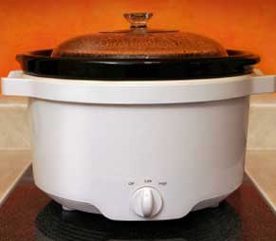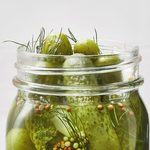Let a Slow Cooker Do the Cooking
Imagine arriving home after a long day at work to a hot meal ready and waiting for you (without having to hire a housekeeper). Let a slow cooker prepare dinner for you while you’re at work.

This handy countertop appliance cooks foods slowly at a low temperature-generally between 76º (168 F) and 137º C (278 F)-to produce delicious main-course meals. You turn on the slow cooker in the morning and your meal is ready when you get home.
The typical slow cooker is made up of two parts. Inside is the glazed ceramic or porcelain pot, which rests in a metal container with a controlled heating element. The outside container heats the ceramic pot gradually, cooking the food over a long period with high enough temperatures to prevent any bacteria forming.
The secret to success is to choose recipes that taste best with long, slow cooking. Soups, baked beans, stews and casseroles are ideal.
Not only do slow cookers save you time, they can also save you money. The long cooking times combined with the steam means leaner meats come out tender and juicy, so you can buy the less expensive cuts. Having your meals ready for you will also cut down on the temptation to order out. You may even see a slight drop in your electric bill since running a slow cooker uses less electricity than a conventional stove.
Things to look for:
- A transparent glass lid, with a chrome housing, that seals but has a steam spout
- Two or more temperature settings, typically low, medium, high amd sometimes a “keep warm” option. Cooking on the high setting should take between four to six hours; low, eight to 10.
- Dishwasher-safe for the inner ceramic pot
- Long enough cord
- Easy grip handles
- Price point: The cheapest brands often deliver inconsistent heat. But there’s no need to go expensive as mid-priced units deliver the same benefit.
- Size: Buy the size you need. Smaller families can opt for the 500 ml (16 oz) size.
Tips for slow cooking:
- Store all ingredients separately in the refrigerator until you’re ready to start cooking to prevent any bacterial contamination.
- Always thaw meat before using it in a slow cooker. It won’t have enough time to cook well if it’s frozen.
- Choose dishes with a high moisture content, such as stews, spaghetti sauce or chilli
- Not too full! Filling the slow cooker halfway to two-thirds is good.
- Put the veggies in first, followed by the meat or poultry.
- Use the low setting for all-day cooking and for less-tender cuts.
- Invest in a slow-cooker cookbook for recipes.



